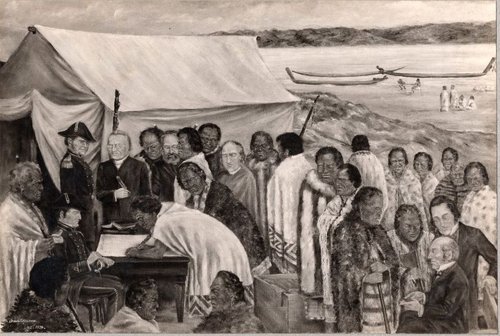
Its significance – a day off, a day to reflect, a day to protest – has evolved over the years and the collections of Ngā Taonga Sound & Vision highlight many of the most important historical events associated with it.
Some of this material is being shared at Waitangi Day events around the country. We are pleased to be working with the National Library Te Puna Mātauranga o Aotearoa for their Waitangi Day at He Tohu. Film from our collection will be shown on a loop in the Public Programmes room throughout the day. The footage will also appear at Wellington City Council’s Te Rā o Waitangi at Waitangi Park. You can view these events on our website.
The first official commemoration of Waitangi Day took place in 1934 – our archive holds a film recording of the events. This followed the gifting to the nation of the Treaty House and surrounding grounds by Governor General Lord Bledisloe two years prior. The 1934 commemoration was a major event with up to 10,000 people attending. The timing was special for many iwi – a century earlier the United Northern Tribes chose a national flag at Waitangi. In 1835 He Whakaputanga was issued, the Declaration of Independence.
Recordings of these commemorations can teach us about historical events, perspectives, and attitudes. They also capture the speeches and likeness of those present. Ngā Taonga holds an extensive audio recording of the Waitangi commemoration during the 1940 Centennial. During one speech, Sir Apirana Ngata spoke passionately and insisted the tone of the event should not be solely celebratory but should also acknowledge the many grievances Māori felt about the signing of the Treaty.
The idea of a national holiday on 6 February had been proposed by a number of successive governments during the 20th century. The mood of the nation and its elected officials changed over the decades, although Māori activism kept a focus on honouring the Treaty. It was in 1974 that 6 February became a public holiday with a day off work– it was however named New Zealand Day by Prime Minister Norman Kirk. He believed that the nation was ready to move forward with a new identity, and a spectacular but divisive show was held on the day. Kirk’s successor Robert Muldoon reinstated the name ‘Waitangi Day’ in 1976.
Hero image: Waitangi Treaty Grounds. (Photo courtesy Fraser Pettigrew)

The Signing of the Treaty of Waitangi, Ōriwa Haddon. (Courtesy Archives NZ)
The 150th anniversary of the signing of Te Tiriti occurred in 1990 – the ‘sesquicentennial’ of the nation. The commemorations were very well attended and included a memorable speech by the Bishop of Aotearoa, Whakahuihui Vercoe. In front of a crowd including HRH Queen Elizabeth II, Prime Minister Geoffrey Palmer and Governor General Sir Paul Reeves, Vercoe said:
“One hundred and fifty years ago, a compact was signed, a covenant was made between two people […] But since the signing of that treaty […] our partners have marginalised us. You have not honoured the treaty […] Since 1840, the partner that has been marginalised is me. The language of this land is yours; the custom is yours, the media by which we tell the world who we are, are yours…”
Radio and television broadcasts of this speech and the rest of the day’s ceremony are held in the Ngā Taonga archives. Broadcasters have played a prominent role in the framing of Waitangi Day and our collections hold recordings featuring Haare Williams, Henare Te Ua, Philip Liner and many others.
The online collection of Ngā Taonga can be searched for a large amount of material related to Waitangi Day.